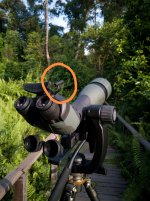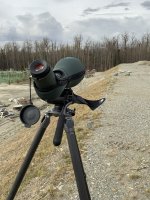Thanks for the comments, I should add that the current viewing is conducted at a Golden Eagle Migration site in the Canadian Rockies. The few visitors to the site that bring angled scopes have difficulties in locating raptors high in the sky, I feel it is because when looking in the sky with no reference point (ie horizon, trees, shoreline etc) it becomes frustrating to initially locate the subject. The order of counting at the site is, 1st) locate with bino's, 2nd) relocate with scope at low power, 3rd) zoom closer and focus so as to age the raptor (that is over a 1000m away), remember while we are doing all this, we are panning across the sky waiting for a moment for the raptor to turn or soar or flex a tail so as to determine an Adult or sub-adult or juvenile, sorry for all the detail. As Alexis comments " Biggest problem with angled is that it cannot be inserted into line of sight. With bins, or with straight scopes, you can be following a moving bird with your eye, then insert the optic in the line of sight" really comes into play, I have had fantasies of the BTX coming out in a Straight View but alas I think it is just that...Fantasy
Michael









